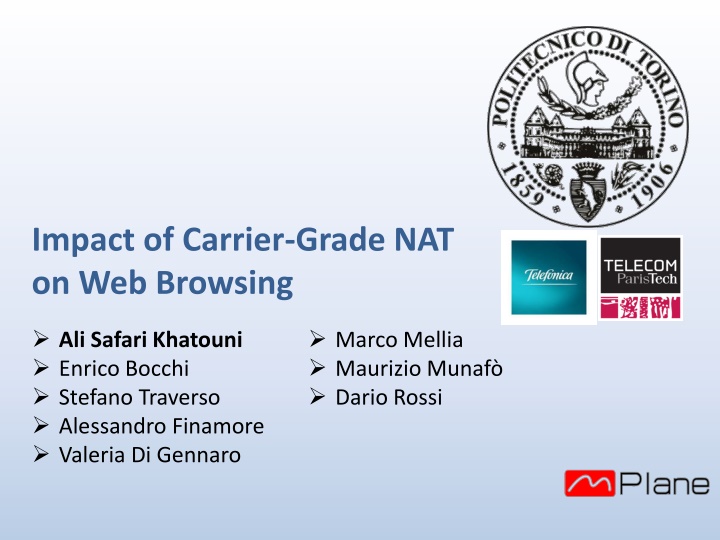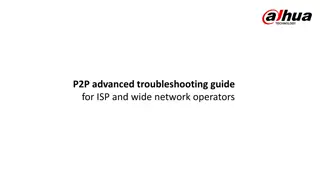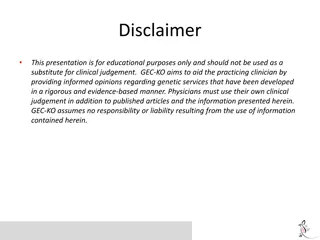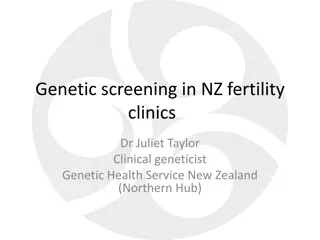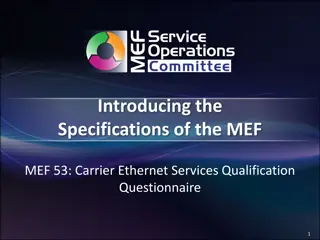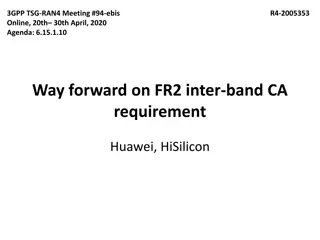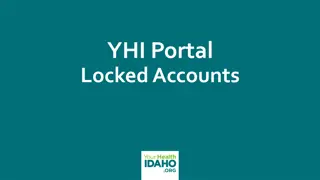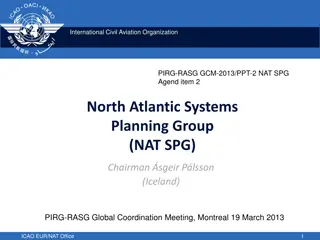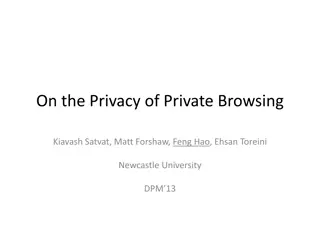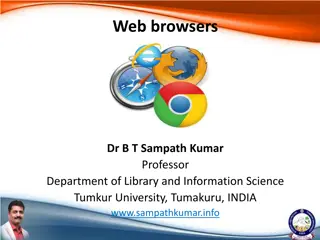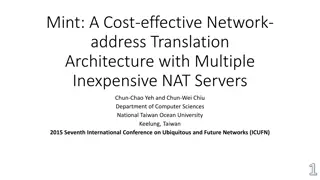Impact of Carrier-Grade NAT on Web Browsing: A Comprehensive Analysis
The research delves into the effects of Carrier-Grade NAT on web browsing, discussing traditional NAT mechanisms, deployment implications of Carrier Grade NAT, and investigation goals. Methodologies for large-scale passive measurement in real ISP deployments are outlined, focusing on monitoring web traffic and performance within a monitoring scenario involving private and public addresses. Through empirical measurements, the study aims to determine the impact of CGN on user browsing experience and assess the benefits of not having a public IP.
Download Presentation

Please find below an Image/Link to download the presentation.
The content on the website is provided AS IS for your information and personal use only. It may not be sold, licensed, or shared on other websites without obtaining consent from the author.If you encounter any issues during the download, it is possible that the publisher has removed the file from their server.
You are allowed to download the files provided on this website for personal or commercial use, subject to the condition that they are used lawfully. All files are the property of their respective owners.
The content on the website is provided AS IS for your information and personal use only. It may not be sold, licensed, or shared on other websites without obtaining consent from the author.
E N D
Presentation Transcript
Impact of Carrier-Grade NAT on Web Browsing Ali Safari Khatouni Enrico Bocchi Stefano Traverso Alessandro Finamore Valeria Di Gennaro Marco Mellia Maurizio Munaf Dario Rossi
NAT at a glance - Traditional NAT44 2 Internet 10.0.0.1 Home NAT 10.0.0.2 128.130.90.61 10.0.0.* 10.0.0.3 Public IP address worldwide unique registered addresses Private IP addresses unregistered addresses
NAT at a glance - Traditional NAT44 3 Internet 10.0.0.1 Home NAT 10.0.0.2 128.130.90.61 10.0.0.* 10.0.0.3 Public IP address worldwide unique registered addresses Private IP addresses unregistered addresses
and Carrier Grade NAT NAT444 4 Internet Home NAT Carrier Grade NAT ISP subnet becomes a large private network Home routers are assigned private IPs The amount of required public addresses is reduced as well as cost ISP Subnet
Carrier Grade NAT (CGN) 5 The deployment of CGN has some implications: Breaks the end-to-end IP connectivity Introduces reachability problems for NAT-ted devices Need of successful NAT traversal techniques Updates of non-NAT friendly applications Mandates the network keeps the state of the connections Impacts negatively lawful intercept May have performance implications Our investigation goals Does CGN impact users browsing experience? Are there any benefits in not having a public IP? Answer with measurements
Methodology roadmap 7 Large scale passive measurement A real ISP deployment Customers are offered public or private address Traffic monitored to extract performance metrics Leverage statistical tools Collect and compare empirical probability distributions Check and assess eventual differences Focus on Web traffic and performance
Monitoring Scenario 8 ISP Point of Presence Private Addresses Internet Carrier-Grade NAT Public Addresses Passive Probe Dataset 1 month of real traffic recorded, October 2014 17,000 household monitored, 40% with public IP address 1.7Billion TCP flows, 0.7Billion HTTP requests http://tstat.polito.it
Measurements 9 Server Household Passive Probe TSYN RTT TWHT TEstablish TRequest TTFB TResponse Time TLast
Assessing the Impact of CGN 10 Consider 9 performance metrics Measure distinct probability distributions for each metric Tied to private and public households Jensen-Shannon Divergence Quantify the difference between a pair of probability distributions Based on the Kullback-Leibler divergence + Symmetric + Bounded to finite value
Jensen-Shannon Calibration 11 Need of a threshold to discriminate between significant and negligible differences Calibration with: Negexp CDF 0 = 1, fixed 1 varies [1 8]
Jensen-Shannon Calibration 12 Recommendations to avoid bias: Tool calibration to avoid measurement artifacts Adequate binning strategy Relevant population size Distribution samples are TCP flows Dataset 1. 2. 1.7B TCP flows 0.7B HTTP requests
Performance Metrics TWHT 14 Service JS Div 1. Three Way Handshake Time (TWHT) All 0.002 Any remote server (all) iTunes contents (phobos.apple.com - Akamai) Google Search (Google.com) Phobos 0.016 Google.com 0.010
Performance Metrics Throughput 15 1. Three Way Handshake Time (TWHT) Service JS Div 2. Download Throughput Any remote server (all) iTunes contents (phobos.apple.com - Akamai) Tumblr Blogging Platform (Tumblr.com) All 0.001 Phobos 0.022 Tumblr 0.021
Performance Metrics Number of Hops 16 1. Three Way Handshake Time (TWHT) 2. Download Throughput Service JS Div 3. Number of Hops Any remote server (all) iTunes contents (phobos.apple.com - Akamai) Google Search (Google.com) All 0.223 Phobos 0.689 Google.com 0.666 Only metric showing noteworthy differences 4 hops more for private customers Affecting any service being contacted 1. 2.
Jensen-Shannon Results 17 Three intervals identified Significant differences Noticeable differences Negligible differences JSdiv 0.1 0.02 JSdiv< 0.1 JSdiv< 0.02 Metric Any Server Google.com Phobos.com Number of Hops 0.223 0.666 0.689 Latency (RTT) 0.001 0.006 0.007 Establish (TWHT) 0.002 0.010 0.016 HTTP 1st(TTFB) Our investigation goals Does CGN impact users browsing experience? We observe no significant impact Are there any benefits in not having a public IP? 0.002 0.006 0.006 Throughput 0.001 - 0.022 Number of SYN <0.001 <0.001 <0.001 Out of Sequence <0.001 - - Duplicates 0.001 0.001 <0.001
Benefits of having a Public / Private IP address
Active Servers 19 Does the customer need IPv4 reachability? Is there any ISP customer running a server at home? Detection technique Look for customers answering at least one incoming connection Protocols: HTTP(S), IMAP(S), POP(S), SMTP(S) No P2P Only 0.6% of customers runs servers at home
Saving in IP addresses using NAT 20 How many active IP are present? Assume an idle timer of 5min at the CGN Active: generated one connection in the last 5min Customer base: ~17000 Max concurrently active: ~7000 Saving due to CGN: ~60%
What about PAT? 21 How many concurrent connection? Concurrent: active in the past 5 min 95% have less than 600 99% have less than 2400 Worst case have more than 20000 Possible saving (with 65k ports) 95% ok => 100x 99% ok => 27x Worst case => 1x
Conclusions 22 Goal: assess the impact of CGN on users web browsing Large scale passive measurements Multiple performance metrics considered Jensen Shannon to pinpoint relevant statistical differences CGN does not harm users web browsing Current investigations How to correctly dimension CGN and what is the saving in IPv4 address? Is there any implications on P2P traffic?
Questions? ali.safari@polito.it http://www.ict-mplane.eu
Unsolicited Traffic 24 What about unsolicited traffic? How many home routers are victims of port-/net- scans? ? Private Addresses Carrier-Grade NAT Public Addresses Compile a list of potential attackers Remote hosts sending TCP-SYN messages to more than 50 IPs in the PoP Focus on destination ports with well-known services or vulnerabilities
Unsolicited Traffic 25 Percentage of victims in PoP Destination Port Description PRI PUB 80 HTTP 1.8 78.5 443 HTTP Secure (HTTPS) 0.1 78.9 143 Internet Message Access Protocol (IMAP) <0.1 79.3 995 Post Office Protocol (POP3 over SSL) <0.1 79.2 25 Simple Mail Transfer Protocol (SMTP) 0.1 79.0 22 Secure Shell (SSH) <0.1 79.2 Our investigation goals 135 MS Remote Procedure Call Does CGN impact users browsing experience? Are there any benefits in not having a public IP? 0.6% of customers needs IPv4 reachability Public IPs are 80x more likely to be victim of attacks <0.1 79.3 3389 MS Windows Remote Desktop 0.1 79.3 1433 MS SQL Server 0.1 79.3 3306 MySQL Server 0.1 79.3 445 MS Active Directory <0.1 79.2
